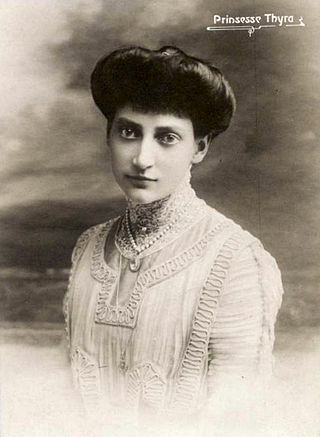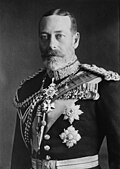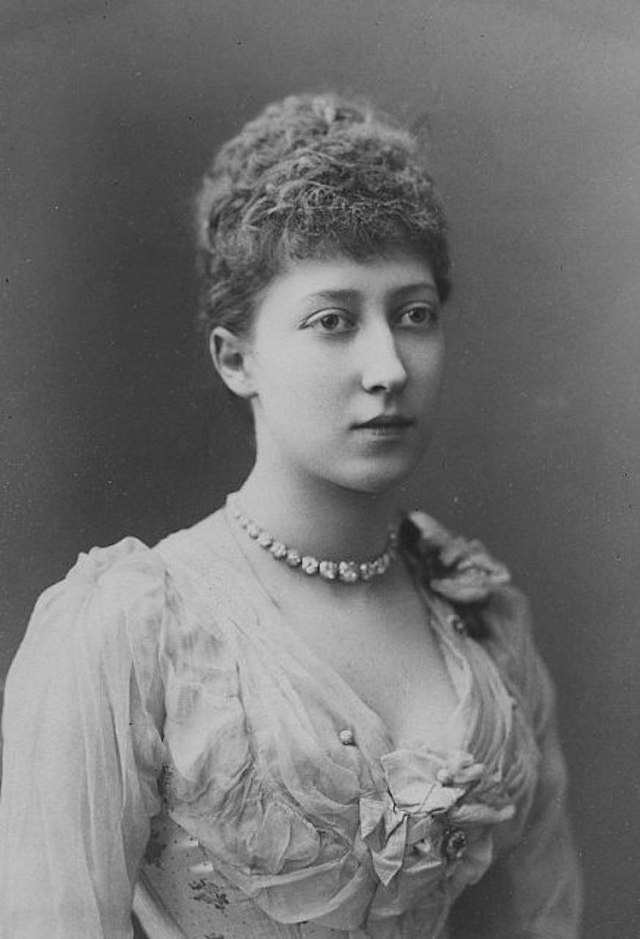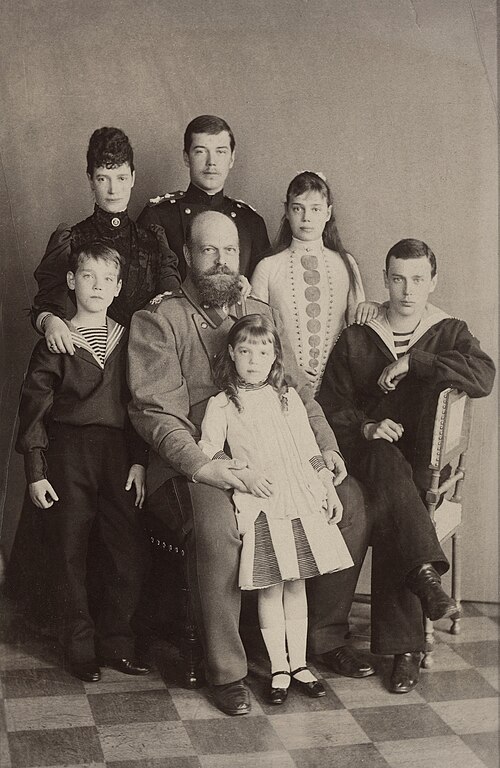Top Qs
Timeline
Chat
Perspective
Descendants of Christian IX of Denmark
Progeny of King Christian IX From Wikipedia, the free encyclopedia
Remove ads
King Christian IX of Denmark (8 April 1818 – 29 January 1906), known as the "father-in-law of Europe",[1] ruled Denmark from 1863 to 1906. He and his queen consort, Louise of Hesse-Kassel (7 September 1817 – 29 September 1898), became the ancestors of many members of European royalty.

In 1842, prior to becoming King of Denmark, Christian married Louise, whose familial connections allowed him to secure his status as the heir-presumptive to the Danish throne in 1852. Christian and Louise had three sons and three daughters together, and the couple actively involved themselves in their children's education because of their limited finances. Although Christian had an affectionate relationship with his daughters, he rejected his eldest son, Frederick, over political differences.
After the commencement of Christian's reign as King of Denmark, his popularity gradually improved among his subjects, partially because of Louise's efforts to marry their children with members of royal families across Europe, including their daughter Princess Alexandra with Albert Edward, Prince of Wales (later Edward VII), and their daughter Princess Dagmar with Alexander, Tsarevich of Russia (later Alexander III).
All of Christian and Louise's six children would go on to have progeny of their own. In addition, some of Christian and Louise's extended descendants would rule as monarchs themselves in European countries. For example, Christian and Louise's grandsons Constantine I, Nicholas II, and George V reigned over Greece, Russia, and the United Kingdom, respectively.
Remove ads
Background
Summarize
Perspective
King Christian IX
For the first 13 years of his life, Christian lived in Germany.[1] Following the death of his father, Friedrich Wilhelm, in 1831, Christian trained as an officer in Copenhagen. He fought on behalf of the Danish Unitary State in the First Schleswig War.[2]
In 1852, Christian became the heir presumptive to the Danish throne. Following the death of his second cousin King Frederick VII 11 years later, Christian became King of Denmark.[1] Due to Christian's German background, he was unpopular among his subjects during the start of his reign.[2] He nearly abdicated in 1864 after Denmark's loss in the Second Schleswig War. Christian's popularity recovered, however, as his children married into several European royal families.[1]
Queen Louise
Born Princess Louise of Hesse-Kassel, Louise became Queen of Denmark in 1863. Because her mother was a sister of King Christian VIII, Louise's marriage to Christian IX was an important factor in his rise to the Danish throne. Moreover, Louise was instrumental in marrying her children across European royalty, which helped increase her husband's popularity among the Danish people.[3]
As Queen of Denmark, Louise exemplified the female ideas of her time. Despite remaining in the shadow of Christian, she showed artistic and social talent. Through her charity work, Louise founded the Diakonissestiftelsen in Copenhagen.[3]
Marriage
Christian and Louise were married in 1842.[2][3][4]
Remove ads
Children
Summarize
Perspective
King Christian IX, together with Queen Louise, had six children: Frederick, Alexandra, George, Dagmar, Thyra, and Valdemar.[3] Because of the strained finances and limited fortunes that Christian and Louise had before 1852, they were actively involved in the education of Dagmar and her siblings during that time.[7] Later, from 1875 to 1900, Christian and Louise would annually welcome their children and grandchildren across six different European royal houses at Fredensborg Palace in Denmark.[8]
Within Christian and Louise's family, Thyra was called the "gentle and good daughter" by her father. In addition, Alexandra and Dagmar were respectively seen as the "pretty" and "clever" girls.[9] In contrast, Christian rejected Frederick, then Crown Prince of Denmark, because of their contrasting conservative and reformist mindsets, respectively.[10] Furthermore, Christian had reservations about George becoming King of the Hellenes after the Greek National Assembly elected the latter to be their monarch, seeing the country's throne as a doubtful proposition. Nevertheless, George successfully persuaded his father and assumed the Greek throne in 1863.[11] This influenced Valdemar's decision to decline an offer for the Bulgarian throne in 1878. He did not want to risk going to war with his brother George, given the relations between Bulgaria and Greece at the time.[12]
Remove ads
Grandchildren
Summarize
Perspective
Christian IX and Louise had 38 grandchildren: eight children of Frederick VIII,[10] six children of Alexandra,[17] seven children of George I,[19][b] six children of Dagmar,[7] six children of Thyra,[9][a] and five children of Valdemar.[12]
Children of Frederick VIII and Louise
At the age of 17, Princess Louise of Sweden became engaged to King Frederick VIII of Denmark, then called Frederick, Crown Prince of Denmark, at Bäckaskog Castle in Sweden. Frederick and Louise would later marry in 1869 in Stockholm.[16] This marriage took place in the context of a desire for a Scandinavian union in both Denmark and Sweden.[27]
Together, Frederick and Louise had eight children.[10][16] Two of these children, Christian and Haakon, became King of Denmark and King of Norway, respectively.[10][27] Frederick and Louise's family came to be defined by Louise's piety. Moreover, Louise oversaw the strictly disciplined education of her children.[27]
Over time, Frederick and Louise's marriage became a reasonably happy one.[27] However, because of Frederick's estrangement from his father,[10][27] he and his wife kept their distance from his relatives. In addition, Louise had difficult relationships with her in-laws in the Danish royal family.[27]
Children of Alexandra and Edward VII
In 1861, Princess Alexandra met King Edward VII of the United Kingdom, then called Albert Edward Prince of Wales, at the Speyer Cathedral in Germany. Edward was the eldest son of Queen Victoria and Prince Albert.[18] Edward later proposed to Alexandra in 1862, and they married in 1863 at St George's Chapel in Windsor Castle in the United Kingdom.[18][17]
Although Alexandra and Edward got along fairly well,[44] Edward engaged in several affairs during their marriage.[17] However, for the most part, Alexandra did not pay attention to her husband's romantic liaisons.[44]
Together, Alexandra and Edward had six children.[17] One of these children, Alexander John, died in infancy.[45] Furthermore, Alexandra and Edward's eldest son, Albert Victor, died in 1892 after contracting an illness during a flu pandemic. Albert Victor's death devastated Alexandra.[17]
The three daughters of Edward and Alexandra, Louise, Victoria, and Maud, were known for being active during their youth. As the daughters aged, they became more withdrawn. Alexandra did not want Louise, Victoria, and Maud to marry because her daughters had two brothers who could potentially follow Edward to the British throne. However, both Louise and Maud eventually married.[45]
Children of George I and Olga
In 1863, the Kingdom of Greece was without a monarch. The royal houses of Europe believed that George I, then Prince William of Denmark, would be a suitable candidate for the Greek throne. Consequently, George traveled to Greece, a country that he had never visited before, that same year to start his reign.[19]
After arriving in Greece, George married Grand Duchess Olga Constantinovna of Russia in 1867. George and Olga had eight children together.[19][b]
Children of Dagmar and Alexander III
Queen Louise, Dagmar's mother, hoped to find a suitable husband for her daughter in the Russian imperial court. Following the marriage of Dagmar's sister Alexandra, Queen Louise dedicated her enthusiasm to making this desire a reality. Eventually, in 1864, Dagmar became engaged to Nicholas Alexandrovich, the then-heir to the Russian throne. However, he died one year later.[7]
While on his deathbed, Nicholas insisted that his brother, Emperor Alexander III of Russia (then called Grand Duke Alexander Alexandrovich of Russia), marry Dagmar.[21] Dagmar gradually developed a romantic attraction toward Alexander.[7] They married in October 1866,[7] and Dagmar took the name Maria Feodorovna after converting to Russian Orthodoxy.[7][21]
Maria and Alexander would go on to have six children together, one of whom, Alexander, did not survive past infancy.[7] Maria adored and spoiled her surviving children, especially Nicholas.[7] Likewise, Alexander adored his daughters.[21]
Of the five children of Maria and Alexander who survived past infancy, George died of tuberculosis. Moreover, Nicholas, Michael, and the former's five children were killed during the Russian Revolution.[7]
Children of Thyra and Ernest Augustus
Finding a suitable husband for Princess Thyra of Denmark was an undertaking for her mother, Queen Louise, who had one potential suitor in mind for Thyra: Prince Ernest Augustus, Duke of Cumberland. Eventually, Thyra married him, which gave her the desired opportunity to have children.[9]
Together, Thyra and Ernest Augustus had six children.[a] Living in Gmunden, Austria, Thyra enjoyed a quiet life which allowed her to spend time with her children. However, two of her sons died at a young age. Prince George died in a car accident on the way to the funeral of his uncle King Frederick VIII of Denmark, and Prince Christian died of appendicitis.[9]
Children of Valdemar and Marie
In 1885, Prince Valdemar of Denmark married Marie of Orléans, a French princess. Together, they had five children who were nicknamed the "naughty children from the Yellow Palace". Nevertheless, both Valdemar and Marie were very popular in Denmark.[12]
Because of Valdemar's interest in ships, he went on long sea voyages, a practice that continued during his marriage to Marie.[12]
Remove ads
See also
- John William Friso – Another European prince with descendants in multiple royal families
- Louis IX, Landgrave of Hesse-Darmstadt – Another European sovereign with descendants in multiple royal families
- Descendants of Miguel I of Portugal – Describes progeny of another European king whose descendants married into multiple royal families
- Nicholas I of Montenegro – Another European king whose descendants married into multiple royal families
- Descendants of Paul I of Russia – Describes progeny of a European emperor with descendants in multiple royal families
- Descendants of Queen Victoria – Describes progeny of one of Christian IX's contemporaries
Remove ads
Footnotes
Further reading
External links
Wikiwand - on
Seamless Wikipedia browsing. On steroids.
Remove ads

















































